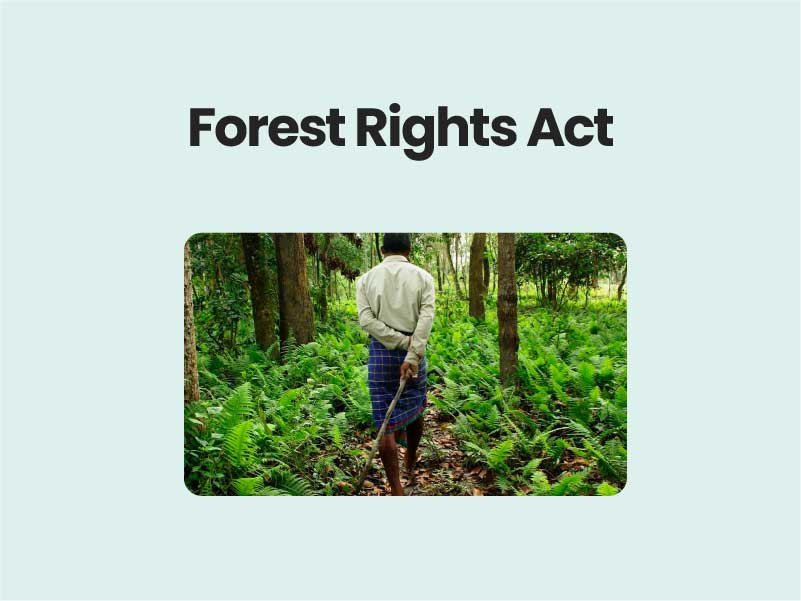Companion@360 → 7 Month programme to sharpen your writing skills → REGISTER NOW

Forest Rights Act
The Forest Rights Act, 2006 was a landmark forest legislation in India, which recognised individual and community rights over forest resources. However, as of November 2018, only 44.83% of titles have been distributed among the total numbers of claims received across the country.
The Forest Rights Act, 2006
- The Scheduled Tribes and Other Traditional Forest Dwellers (Recognition of Forest Rights) Act, 2006 is a result of the protracted struggle by the marginal and tribal communities of our country to assert their rights over the forestland over which they were traditionally dependent.
- This Act is crucial to the rights of millions of tribals and other forest dwellers in different parts of our country as it provides for the restitution of deprived forest rights across India, including both individual rights to cultivated land in forestland and community rights over common property resources.
- The notification of Rules for the implementation of the Forest Rights Act, 2006 on 1st Jan 2008, has finally paved the way to undo the ‘historic injustice’ done to the tribals and other forest dwellers.
Community forest rights:
- Community forest rights recognized under the Forest Rights Act are important for securing livelihoods of the forest communities and for strengthening local self governance of forests and natural resources.
- The CFR link is a part of a collective initiative for collection and sharing of information on CFR from different states. The collection and sharing of information is coordinated by Vasundhara and Kalpavriksh with support from Oxfam.
Community Forest Rights-Learning & Advocacy (CFR-LA):
- Community Forest Rights-Learning & Advocacy (CFR-LA) process is national level effort for exchange of information and learning and for evidence-based advocacy on Community Forest Rights (CFR) provisions of the Forest Rights Act.
- The process includes organizations and individuals working at the local, regional, national and international level on understanding and facilitating CFRs.
Challenges:
- Conservation and ecological restoration by communities:Forest communities of this country have successfully invoked their powers and rights under FRA to stop potential deforestation from large scale environmentally destructive projects. The Supreme Court has in the past taken cognizance of these powers and rights (e.g. Niyamgiri).
- Tribal economy, livelihoods and employment: It is estimated that about 20 lakh tribals and forest dwelling families, whose claims have been arbitrarily and often illegally rejected, face threat of eviction, but the actual population that might get affected would be almost about 1 crore.
- Vulnerable communities: The SC order is likely to further marginalize a large population of vulnerable communities who are the particularly vulnerable tribal groups (PVTGs), nomadic and pastoral communities, dalits, women, residents of forest villages and unsurveyed villages and displaced communities. The rights of these communities and their claims have been largely ignored and also rejected in most cases
- Atrocities against women, tribals and forest dwellers: There are reports of atrocities and harassment by forest officialsrelated to many incidents of carrying out forcible plantations and fencing in lands claimed under FRA, diversion of forest land for mining in violation of forest rights and without mandatory consent from Gram Sabha, and eviction drives against forest dwellers from forests and the Protected Areas.T
- Conflicts in tribal areas: -High percentage of rejection (about 70 to 80 percent) in sensitive and conflict-prone regions will most definitely lead to more disaffection and unrest. There is genuine apprehension that the SC order for eviction and consequent actions by the authorities can only increase conflicts.
Way Forward:
- The Centre in cooperation with State governments should implement the Forest Rights Act, 2006 in its right spirit.
- Reforming Forest Bureaucracy
- Need to provide marketing and MSP support to non-timber forest products and create institutional mechanisms to support community forest enterprises for value addition.
Read Also Melghat Tiger Reserve
